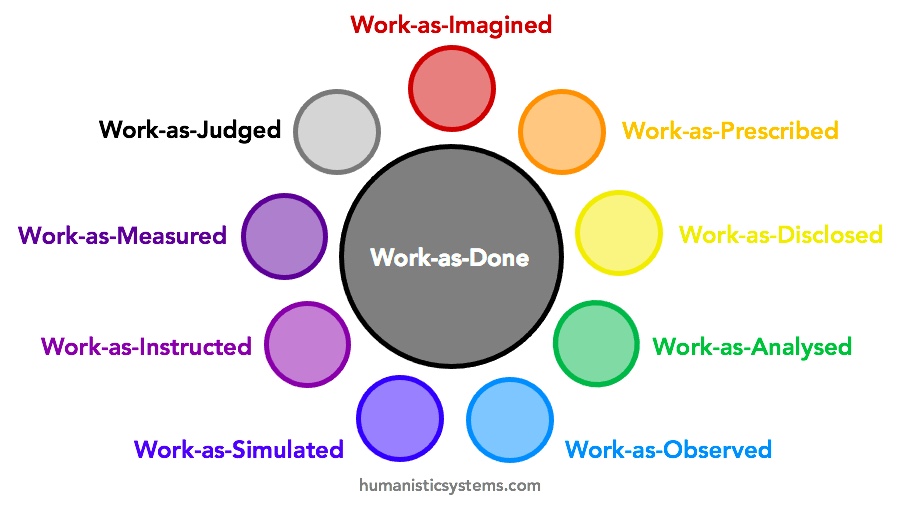In any attempt to understand or intervene in the design and conduct of work, we can consider several kinds of ‘work’. We are not usually considering actual purposeful activity – work-as-done. Rather, we use ‘proxies’ for work-as-done as the basis for understanding and intervention. In this series of short posts, I outline briefly some of these proxies. (See here for a fuller introduction to the series.)

Other posts in the series
- Work-as-Imagined
- Work-as-Prescribed (this post)
- Work-as-Disclosed
- Work-as-Analysed
- Work-as-Observed
- Work-as-Simulated
- Work-as-Instructed
- Work-as-Measured
- Work-as-Judged
Work-as-Prescribed
Work-as-prescribed is the formalisation, specification and design of work. It is the work that people ‘should do’, especially according to policies, procedures, rules, and so on.
Function and Purpose: Work-as-prescribed is the formalisation, specification and design of work, based on any of the other proxies (usually a combination). Work-as-prescribed is intended to define and direct how work ought to be done to achieve its objectives, and often why it ought to be done this way. It has many related purposes concerning work and artefact design (e.g., task analysis, standardisation), competency (e.g., training, performance evaluation), safety and quality (e.g., assessment, investigation, audits), and justice (e.g., judicial proceedings).
Form: Work-as-prescribed takes a number of forms, including laws, regulations, rules, procedures, checklists, standards, job descriptions, management systems, user interfaces, as well as normative or prescriptive customs (‘the way we do things around here’). Some of these are more task-oriented (e.g., procedures, checklists) while others are more job-oriented (e.g., job descriptions, regulations). Work-as-prescribed can be embedded in traditional documents, or integrated into interface design, or simply accepted customs and practices.
Agency: Work is often prescribed by more senior members of an organisation (e.g., supervisors and middle managers), or by specialists (e.g., procedure writers), and external organisations, such as standards organisations, regulators (e.g., work time limits) and policy-makers (e.g., performance targets).
Variety: While there is an infinite variety of work-as-imagined, work-as-prescribed is limited in its variety, with each task having one or a small number of prescribed methods (though each job may have many, sometimes amounting to thousands of pages of detailed procedures).
Stability: Work-as-prescribed will tend to change slowly with updates and revisions to policies, procedures, standards, norms, and so on. In written form, it may persist even as the actual work or job in question no longer exists, or has changed substantially (defunct archetype).
Fidelity: Work-as-prescribed is unique in that it is assumed to be the correct (and therefore safe) way to work. As such, work-as-prescribed should form reasonably accurate descriptions of how work ought to be done. It should also reflect how work really is done, since there can be consequences (for safety and justice, for example) when there are significant gaps between the two. Work-as-prescribed is also an arbiter of whether performance is satisfactory. However, it is usually impossible to prescribe work-as-done fully in the way that it really is done – even work that is well-understood. Except for very simple tasks, it is just not possible to articulate – especially in a linear written form – the precise way that much work is done. This is because of the variable nature of work-as-done (between different individuals and by the same individuals over time and in different situations). This is especially true for work-in-the-head (task switching, risk assessment, judgement), which is covert, even if the resulting behaviours are observable. Work-as-done is also inextricably connected to people, contexts, and tools, and the combinations of these are more or less infinite, and so impossible to prescribe in a way that will fully align with reality.
Completeness: Work-as-prescribed may form a more-or-less complete prescription of overt activity, but at different levels of granularity. At a coarse level of granularity, there will be laws, regulations and policies that cover the work. Depending on a range of factors (e.g., criticality to quality or safety) certain aspects of work-as-done will be prescribed in greater resolution. As noted above, not all aspects of work-as-done can be prescribed, and so work-as-prescribed will never be complete. Again, this especially applies to work-in-the-head.
Granularity: Work is prescribed at different levels of granularity from course (e.g., laws, regulations, or general principles of work) to fine (e.g., detailed procedure steps, user interface dialogues). In some cases, there may be relatively little specification, so that work-as-prescribed leaves the details up to the workers. In other cases, each task step may be prescribed in detail – especially for more linear tasks such as can be found in manufacturing. No matter what the level of granularity, procedures, standards, regulations, etc., lack the detail, richness and subtlety of actual work, including the many interdependencies and conditions. The Catch-22 of work-as-prescribed is that the more specified the work is, the more incorrect is it likely to become in messy work situations where everything ‘depends’ (on the situation, primarily).

This work is licensed under a Creative Commons Attribution-NonCommercial-NoDerivatives 4.0 International License. CC BY-NC-ND 4.0